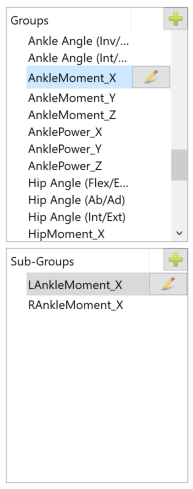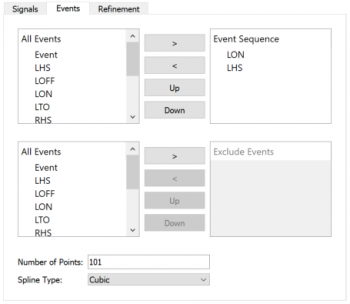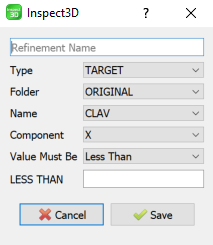Inspect3D Advanced Query Section: Difference between revisions
(Reduced heading levels and cleaned up terminology.) |
|||
| Line 6: | Line 6: | ||
The Group Definition dialog is used to define the queries that will extract signals from the loaded CMZ library. The dialog also allows you to group specific signals together based on a number of possible features, e.g. right/left or intact/affected. | |||
The | |||
[[Image:FullAdvancedQueriesDialogue3.png]] | [[Image:FullAdvancedQueriesDialogue3.png]] | ||
==Auto-Populate Groups== | ==Auto-Populate Groups== | ||
More information about Auto-Populating Groups can be found [[Inspect3D:_AutoPopulate_Groups|here]]. | Inspect3D has the convenient ability to automatically define queries based on common signals and groupings. This feature saves the user from the tedious task of manually defining common queries. More information about Auto-Populating Groups can be found [[Inspect3D:_AutoPopulate_Groups|here]]. | ||
== | ==Query Definition File== | ||
[[Image:I3DAdvancedQueriesDialogueLoadSave.png]] | [[Image:I3DAdvancedQueriesDialogueLoadSave.png]] | ||
Inspect3D also allows users to save time by saving queries definitions to a [[.q3d]] file so that they can be easily re-used during future analysis. This capability is at its most useful when using the Load Group Def & Compute Groups option in the Group Definitions drop-down menu. | |||
==Groups and Sub Groups== | ==Groups and Sub Groups== | ||
| Line 28: | Line 24: | ||
{| style= width="100%" | {| style= width="100%" | ||
| style="width: 50%" align="left" style="vertical-align:top"| | | style="width: 50%" align="left" style="vertical-align:top"| | ||
You can define Groups and Sub-Groups | You can define Groups and Sub-Groups for the signals in the CMZ library/ | ||
* A <b>Group</b> would be "AnkleMoment_X" | * A <b>Group</b> would be "AnkleMoment_X" | ||
* A <b>Sub-Group</b> would be "LAnkleMoment_X" and "RAnkleMoment_X" | * A <b>Sub-Group</b> would be "LAnkleMoment_X" and "RAnkleMoment_X" | ||
* A group can have as many Sub-Groups as necessary (1-N) | * A group can have as many Sub-Groups as necessary (1-N) | ||
Names for Groups and Sub-Groups can include spaces and special characters. Note, however, that some special characters can cause difficulty for updating CMZ libraries with exclusions. Sub-Group names can be repeated between different groups but not within a single group. | |||
| style= "width: 50%" align="right" style="vertical-align:top"| | | style= "width: 50%" align="right" style="vertical-align:top"| | ||
[[Image:I3DAdvancedQueriesDialogueQueryName2.png|right]] | [[Image:I3DAdvancedQueriesDialogueQueryName2.png|right]] | ||
| Line 40: | Line 36: | ||
==Sub-Group Definition== | ==Sub-Group Definition== | ||
The Sub-Group Definition lets you define the signals you want to query. | The Sub-Group Definition lets you define the signals you want to query. Query results are defined according to the signals you want from the CMZ library, the events or event sequences to which you want to time normalize the signals, and any further refinements that you want to apply, e.g., threshold values. | ||
1. Signals | |||
{| style= width="100%" | {| style= width="100%" | ||
| Line 56: | Line 52: | ||
|} | |} | ||
2. Events | |||
{| style= width="100%" | {| style= width="100%" | ||
| Line 72: | Line 68: | ||
|} | |} | ||
3. Refinement | |||
{| style= width="100%" | {| style= width="100%" | ||
| Line 89: | Line 85: | ||
{| style= width="100%" | {| style= width="100%" | ||
| style="width: 50%" align="left" style="vertical-align:top"| | | style="width: 50%" align="left" style="vertical-align:top"| | ||
Refinements allow you to specify additional criteria that must be met before a signal in brought into the group you define. The following information is required to specify a refinement: | |||
* <b>Refinement Name:</b> Each refinement in a sub-group requires a unique name | * <b>Refinement Name:</b> Each refinement in a sub-group requires a unique name | ||
* <b>Signal Definition:</b> Specify the signal you want to work with as it is referenced in the [[Data_Tree_Summary|Visual3D Data Tree]] | * <b>Signal Definition:</b> Specify the signal you want to work with as it is referenced in the [[Data_Tree_Summary|Visual3D Data Tree]], i.e., Type, Folder, Name, and Component. | ||
* <b>Value Must Be:</b> There are 6 types of criteria that can be specified for a refinement. | |||
** <b>Less Than</b>: The signal must be less than the specified threshold to be included | |||
** <b>Greater Than</b>: The signal must be greater than the specified threshold to be included | |||
** <b>Equal To</b>: The signal must be equal to the specified threshold to be included | |||
* <b>Value Must Be:</b> | ** <b>Not Equal To</b>: The signal must not be equal to the specified threshold to be included | ||
** <b>Less Than</b>: | ** <b>Between</b>: The signal must be between the two specified values to be included | ||
** <b>Greater Than</b>: | ** <b>Manual</b>: The signal must satisfy the specified [[Expressions|Visual3D Expression]] | ||
** <b>Equal To</b>: | |||
** <b>Not Equal To</b>: | |||
** <b>Between</b>: | |||
** <b>Manual</b>: | |||
| style= "width: 50%" align="left" style="vertical-align:top"| | | style= "width: 50%" align="left" style="vertical-align:top"| | ||
[[File:I3D_GroupDef_RefinementDialog.png|250px]] | [[File:I3D_GroupDef_RefinementDialog.png|250px]] | ||
Revision as of 18:42, 10 November 2022
| Language: | English • français • italiano • português • español |
|---|
The Group Definition dialog is used to define the queries that will extract signals from the loaded CMZ library. The dialog also allows you to group specific signals together based on a number of possible features, e.g. right/left or intact/affected.
Auto-Populate Groups
Inspect3D has the convenient ability to automatically define queries based on common signals and groupings. This feature saves the user from the tedious task of manually defining common queries. More information about Auto-Populating Groups can be found here.
Query Definition File
Inspect3D also allows users to save time by saving queries definitions to a .q3d file so that they can be easily re-used during future analysis. This capability is at its most useful when using the Load Group Def & Compute Groups option in the Group Definitions drop-down menu.
Groups and Sub Groups
Sub-Group Definition
The Sub-Group Definition lets you define the signals you want to query. Query results are defined according to the signals you want from the CMZ library, the events or event sequences to which you want to time normalize the signals, and any further refinements that you want to apply, e.g., threshold values.
1. Signals
|
Name of the signal as it is referenced in the Visual3D Data Tree:
|
2. Events
|
Events you want to use to normalize the data to:
|
3. Refinement
|
Refinement:
|
|
Refinements allow you to specify additional criteria that must be met before a signal in brought into the group you define. The following information is required to specify a refinement:
|





